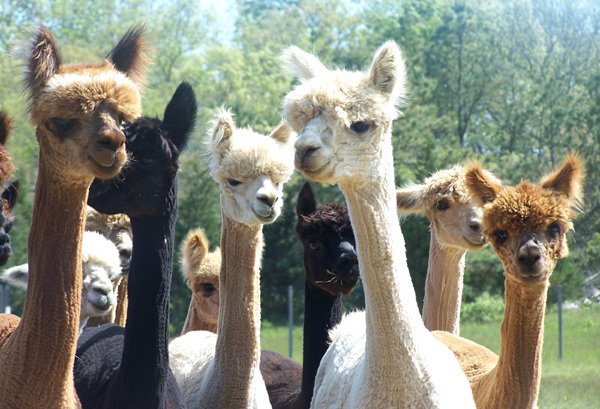Alpaca: An Obvious Choice for Pashen Collection
Alpacas, cousins to the llama, are beautiful, intelligent animals native to the Andean Mountain range of South America, particularly Peru, Bolivia, and Chile. The alpacas, which provide the fiber for Pashen Collection styles, are from Peru.
Adult alpacas grow to approximately 36 inches in height and generally weigh between 150 and 200 pounds. They do not have horns, hooves, claws or incisors. They are alert, curious and predictable. They are social animals that seek companionship and communicate most commonly by softly humming.
Alpacas are shorn, without harm, every 12 to 18 months. They produce five to 10 pounds of luxurious fiber. Long ago, alpaca fiber was reserved for royalty. Today it is purchased in its raw fleece form by hand-spinners and fiber artists, and by knitters as yarn.
Alpaca fiber is very soft, have the luster of silk, and is warm yet lightweight. It comes in 22 natural colors, yet it can be dyed any desired shade.
Containing no lanolin, alpaca fiber is also naturally hypoallergenic. Most people who are sensitive to wool derived from other sources find that they can wear alpaca without the itching or irritation they experience from wool because alpaca fiber is smooth. Other characteristics include: stretch, water repellency and odor reduction. For travelers, clothing made from alpaca is desirable because it is wrinkle-resistant.
Sensitive to their environment in every respect, alpacas have soft padded feet instead of hooves and can leave even the most delicate terrain undamaged. Damage to topsoil decreases long-term soil fertility and in the process, the soil is eroded and weed invasion is encouraged.
Alpacas prefer to eat tender grasses, which they do not pull up by the roots. Lacking upper teeth, they “cut” the grass with their bottom teeth and upper palate. This vegetation cutting encourages the plants’ growth. Because they are modified ruminants with a three-compartment stomach, they convert grass and hay to energy very efficiently and stop eating when they are full, further preserving the landscape on which they live. Alpacas also do not mind eating brush, fallen leaves and other “undesirable” vegetation.
Alpacas’ pellet-like droppings are PH balanced and are an excellent, natural, slow-release, low-odor fertilizer. This rich fertilizer is perfect for growing fruits and vegetables. Because alpacas consolidate their feces in one or two communal spots in the pasture, it is easy to collect and compost, and the spread of parasites is controlled.
While alpacas are environmentally friendly … and even beneficial… to the land, what makes them even more ‘green’ is the fiber they produce. No chemicals are employed either during feeding or during the industrial production of alpaca fleece into fiber. If dyeing is desired, only 20% of a normal dye quantity is required. All fiber from an alpaca can be used – even the fiber from the lower legs, belly, neck, etc is being used for things such as natural weed mats to be placed around trees. Alpaca fiber is biodegradable. Alpacas require no insecticides, herbicides or fertilizers that pollute the groundwater.
Whether it be tops, bottoms, knit accessories, or woven bags all of these wonderful attributes make alpaca a perfect fit for Pashen Collection!
(Source for reference: Alpaca Owners and Breeders Association)
